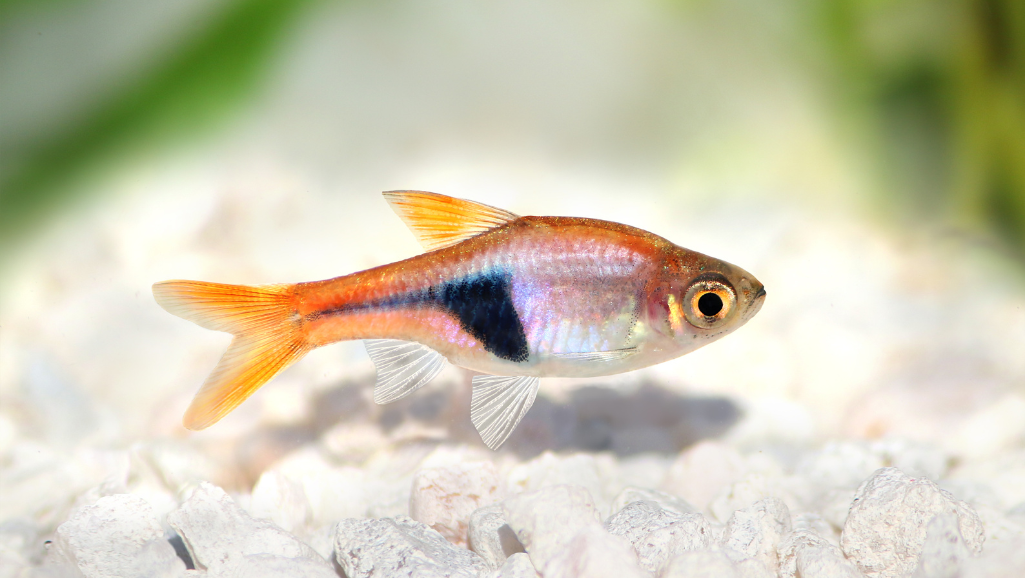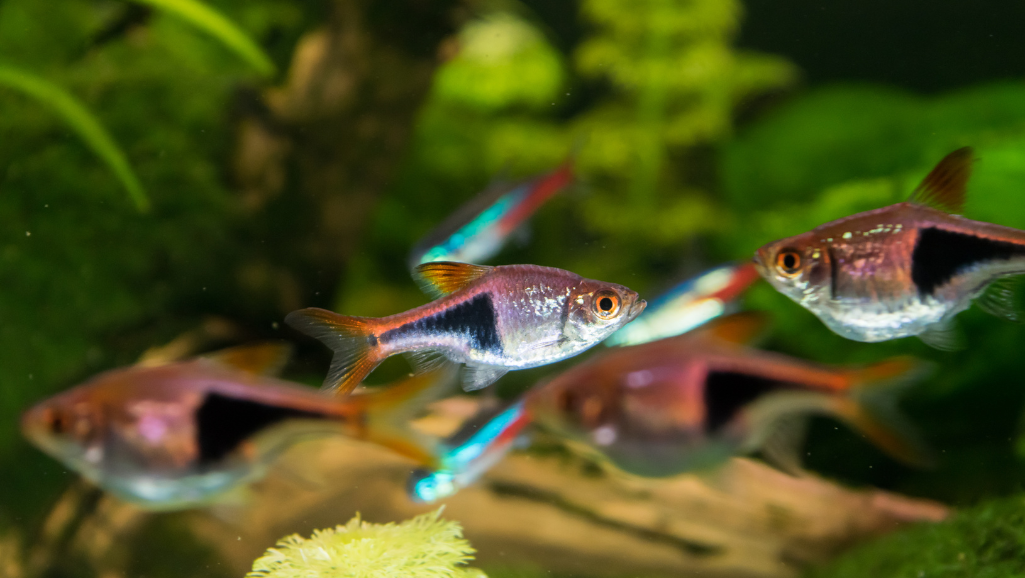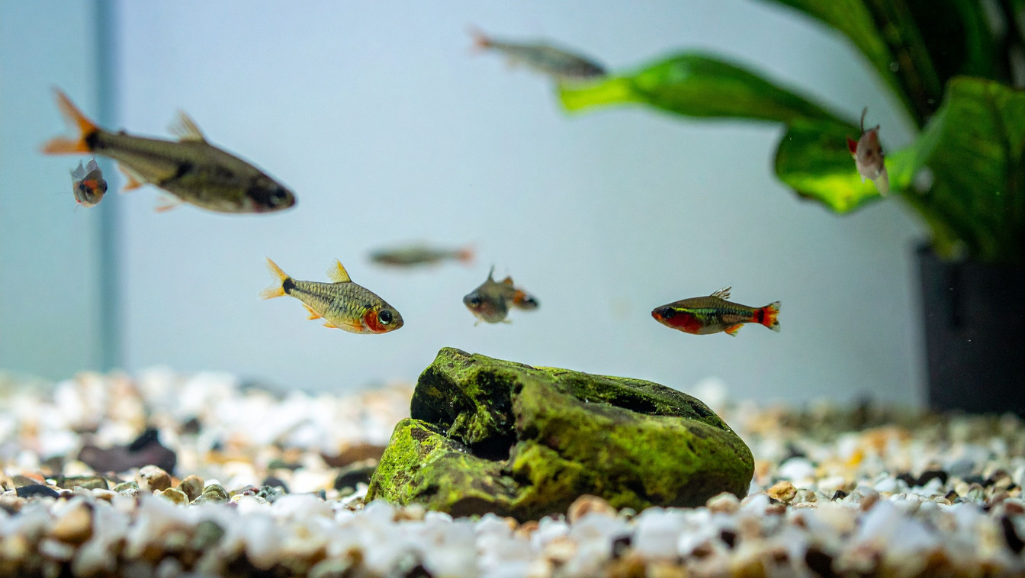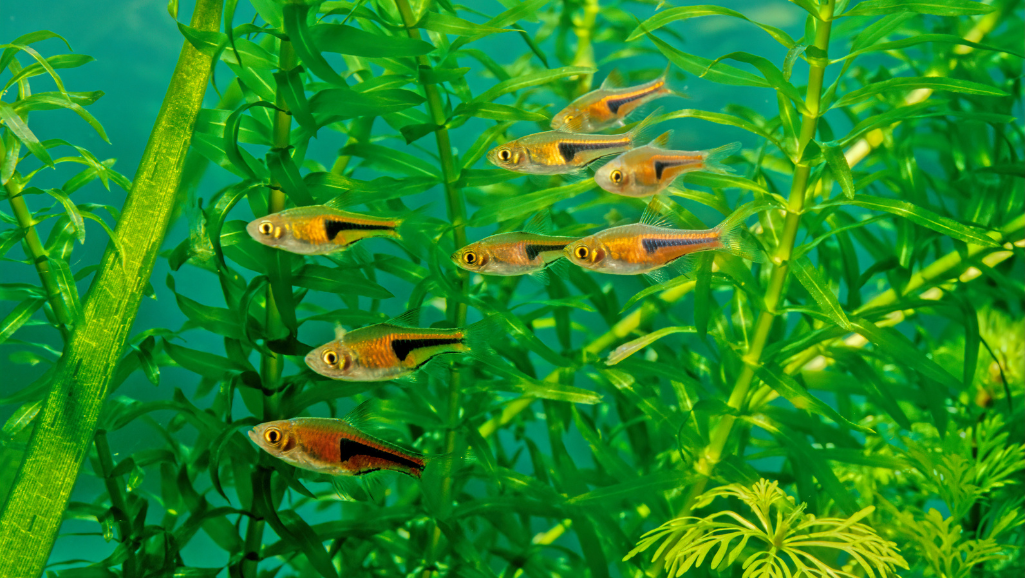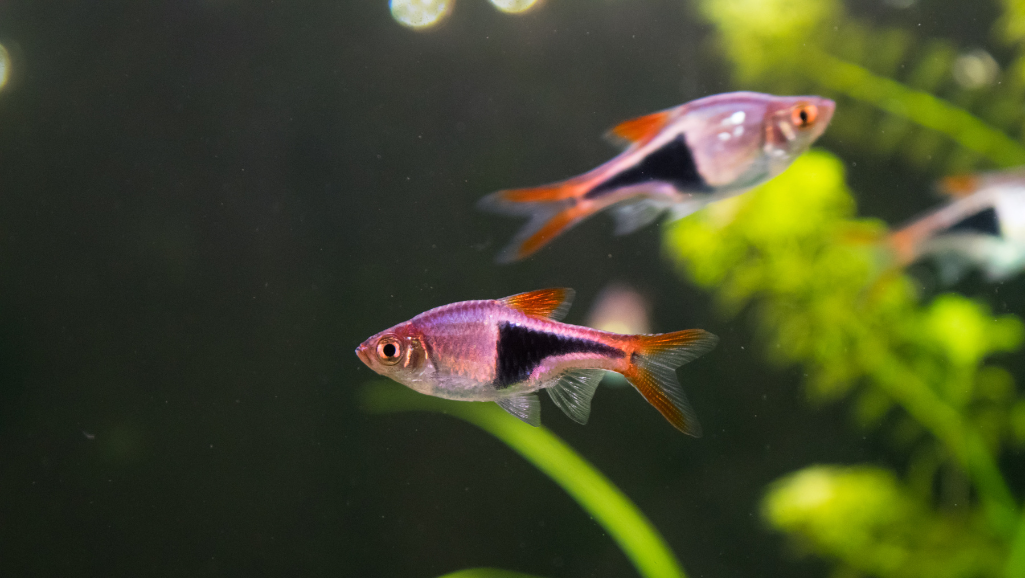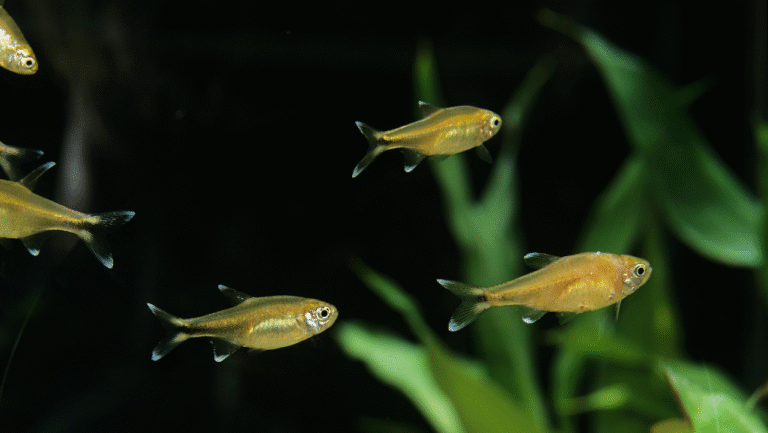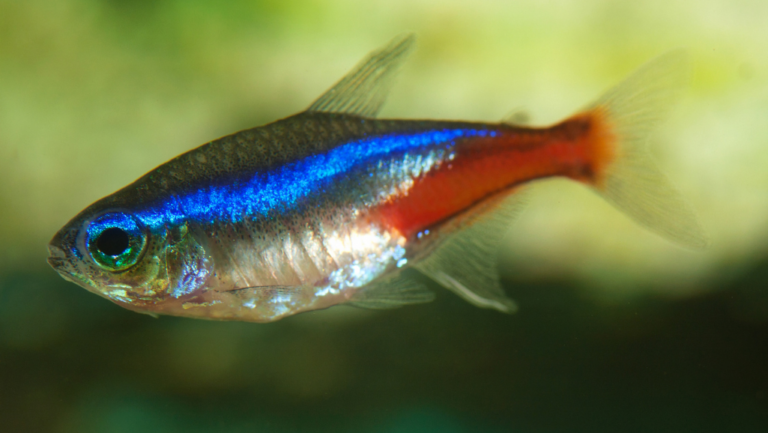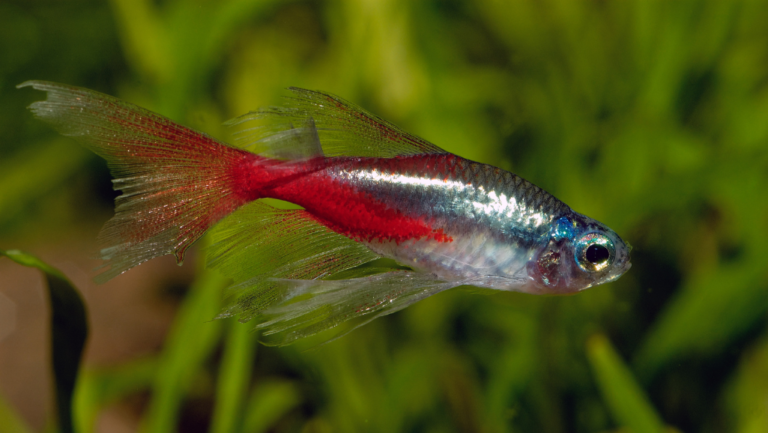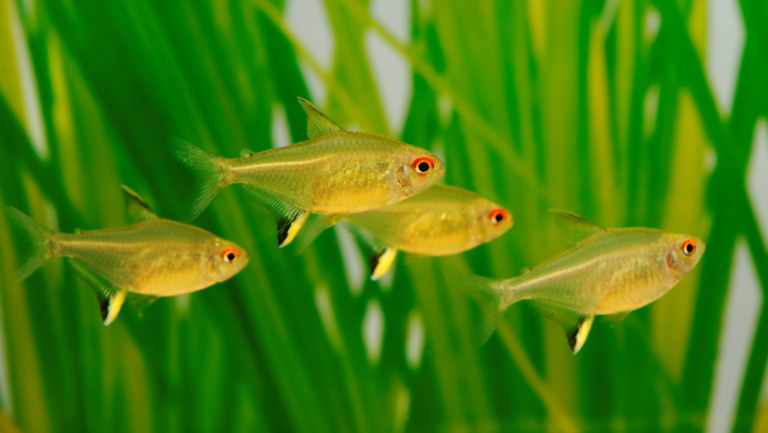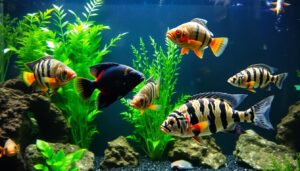Meet the scissortail rasbora, a graceful freshwater fish species that brings shimmer and lively motion to any home aquarium.
Known by the scientific name Rasbora trilineata, this rasbora is prized for its deeply forked “scissor” tail and a bold horizontal stripe along a sleek silver flank. Adults are typically small-bodied in the trade (see size note below), and with steady care they commonly live around three to five years.
Native to streams and rivers across Southeast Asia, scissortail rasboras prefer soft, slightly acidic to neutral water kept in the mid-70s °F. They are peaceful, schooling top- to mid-water swimmers and show best in a longer tank that provides open swimming space.
These adaptable fish accept flakes, micro-pellets, frozen foods, and live treats such as brine shrimp. Keep a tight-fitting lid and house them in a confident group of six or more so the school displays strong color and natural schooling behavior. Read on for quick setup and care tips to get your tank ready.
Key Takeaways
- Distinctive forked tail and horizontal stripe make this species a striking centerpiece.
- Maintain soft, slightly acidic to neutral water around 72–78°F for peak color.
- Minimum 20-gallon long tank recommended to allow open, lateral swimming.
- Omnivorous diet: flakes or micro-pellets as staples, with frozen and live foods rotated in.
- Peaceful community fish—keep in groups of six or more to reduce stress and deepen color.
Meet the Scissortail Rasbora: Appearance, Size, and Personality
Also called the three-lined rasbora, the scissortail rasbora is unmistakable in a community tank. A sleek, silvery body carries a bold horizontal stripe from gill to tail, and the deeply forked tail fin often shows yellow, black, and white banding—features that give this rasbora its common name.
Signature look and motion
Notice the shimmer—tiny iridescent scales flash under soft light, making the horizontal stripe stand out as the school cruises. The scissortail rasbora frequently opens and closes its forked tail like tiny scissors while hovering or darting; that scissor-like motion adds personality whether they’re cruising or pausing in midwater.
Size, lifespan, and social habits
Size & lifespan: trade specimens vary, but adults are generally compact; confirm local size ranges (see notes). With steady care, many scissortail rasboras live about three to five years in home aquariums.
Social behavior: these rasbora are peaceful, schooling mid- to top-level swimmers. They form tight groups that reduce stress and deepen color—so keep them in groups rather than singly or in pairs to encourage natural, synchronized swimming.
- Three-banded tail pattern and forked tail make the species visually memorable.
- Slim body and schooling instincts favor longer tanks that provide lateral swimming lanes.
- Healthy behavior: relaxed, cohesive schools and smooth, active swimming in the upper two-thirds of the aquarium.
Planning Your Aquarium: Tank Size, Layout, and Open Swimming Space
Give your scissortail rasbora room to glide: favor a long, low tank that encourages natural, fluid motion and reduces stress. Start with a minimum 20-gallon long aquarium to provide the lateral distance these active rasboras need for sustained schooling and coordinated swimming.
Why length matters: horizontal space lets schools form neat, synchronized lanes. A longer tank improves water flow patterns and oxygenation across the aquarium and reduces sudden directional changes that can spook the school. Vertical, tall tanks restrict lateral movement and may increase skittishness.
Layout tips for clear lanes
Arrange plants, driftwood, and smooth rocks around the perimeter to create a river-like corridor through the center. Use low-profile midwater décor and shorter foreground plants so sight lines stay open and the group can maintain cohesive schooling.
Example layout: a 20-gallon long with 8–12 scissortail rasboras — perimeter planting, a few driftwood pieces, and an open central lane where the school can cruise.
Substrate, flow, and safety
Use a darker substrate such as fine black sand or dark gravel to make iridescent scales pop and to reduce glare. Provide gentle to moderate circulation from a canister or hang-on-back filter—aim for smooth surface movement without strong jets that buffet the fish (look for a gentle return or adjustable spray bar on small tanks).
Secure lids are essential. These top- to mid-dwellers can jump if startled, so seal gaps around equipment and use a tight-fitting cover. Consider a ventilated mesh hood or glass top with a clip-on cover to prevent escapes while allowing airflow.
- Minimum: 20-gallon long tank to allow lateral schooling.
- Perimeter décor creates clear central lanes and a comfortable habitat.
- Darker substrate and mild current enhance color and encourage natural swimming.
- Use a tight lid or secure cover to prevent jumping.
Water Parameters for Peak Health and Color
Maintain steady aquarium chemistry—consistency matters more than chasing exact numbers when you want bright color and healthy behavior from your school.
Ideal ranges: aim for a stable temperature in the mid-70s °F (about 72–78°F), pH that leans slightly acidic to neutral (roughly 6.0–7.5), and soft to moderately hard water around 2–12 dGH. These conditions mimic the gentle streams that make up the species’ natural habitat and help support vivid pigmentation.
Filtration and current
Use reliable biological filtration and create gentle circulation so oxygen stays high and waste is removed efficiently. For most tank setups, aim for smooth turnover that creates surface movement without strong jets—adjustable return outlets or a spray bar work well to provide a steady, non-turbulent flow that encourages natural swimming.
Peat, tannins, and additives
If your tap water is hard or alkaline, consider peat granules or blackwater extracts to gently lower pH and soften water. Tannins from peat or driftwood can deepen colors and recreate a more natural feel—use additives sparingly and monitor parameters closely after any change.
Stability and acclimation
Prioritize stability. Sudden swings in temperature, pH, or hardness stress fish more than steady, slight differences from wild parameters. Match source water where possible and add new fish gradually; cross-reference quarantine and acclimation steps in the Buying/Acclimation section.
- Quick test-kit checklist: ammonia 0 ppm, nitrite 0 ppm, nitrate < 20–40 ppm, pH 6.0–7.5, GH 2–12 dGH, temperature 72–78°F.
- Perform small, regular water changes (for example 10–20% weekly) rather than infrequent large swaps.
- Keep preheated, conditioned water ready to avoid temperature dips during maintenance and to speed safe water changes.
Lighting and Aquascape Ideas that Inspire
Low, diffuse illumination creates a forest‑stream mood that highlights horizontal stripes and motion. Subdued lighting lets silver flanks flash without overstimulating your scissortail rasboras and helps keep algae in check when paired with good maintenance.
Subdued lighting and photoperiod tips for shimmering scales
Set a gentle photoperiod of about 8–10 hours of soft light daily. Choose dimmable LED fixtures or lights with a ramp feature so you can slowly ramp up and down to avoid sudden changes. For planted tanks with Java moss, aim for low-to-moderate intensity (roughly 20–40 µmol/m²/s or a conservative lumen output suitable for low-light plants).
Keep light levels steady to reduce stress and limit algae blooms—try a consistent schedule (for example: ramp 30 minutes on → 8 hours steady → ramp 30 minutes off).
Java moss and dark substrates to mimic forested streams
Pair a dark substrate (fine black sand or dark gravel) with driftwood, smooth rocks, and woven Java moss to recreate leaf-littered riverbeds. These textures create natural contrast that makes the rasboras’ horizontal stripes and shimmering scales stand out.
Leave the midwater zone open so schools can flash and turn in unison. Add a modest current to animate plants and create natural movement without creating strong turbulence that stresses schooling fish.
- Use subdued, diffuse lighting (8–10 hours) to show iridescence without overstimulation.
- Do: weave Java moss into hardscape and provide shaded retreats. Don’t: overplant the central lane—keep it open for schooling.
- Balance contrast and maintenance access—dark substrate + perimeter planting works well for both appearance and husbandry.
Diet and Feeding: From Flakes to Live Foods
What and how you feed these active fish shapes their color, growth, and overall vitality. A reliable staple diet with periodic protein boosts keeps a school of scissortail rasboras lively and well conditioned.
Balanced staples:
Everyday staples: flakes, micro-pellets, and granules
Build daily meals around high-quality flakes or micro-pellets sized for small mouths. Choose complete formulas formulated for small omnivores so vitamins and base nutrition are covered. For example, a light pinch of flakes or a small spoonful of micro-pellets once or twice daily is a good baseline for a 10-fish group—adjust portions so the school finishes food within about 1–2 minutes.
Color-boosting options: live and frozen treats
Rotate in live foods and frozen fare such as brine shrimp, daphnia, and bloodworms to boost color and conditioning. Use frozen foods as occasional protein-rich supplements (2–3 times per week) and reserve live foods for conditioning before breeding or as a special treat.
Portions, frequency, and clean water
Feed small portions 2–3 times daily or once–twice daily depending on stock density and observe how quickly the group consumes the food. Remove uneaten food after feeding to protect water quality. Thaw frozen foods fully and rinse briefly if they carry excess liquid or preservative solution to reduce phosphate load.
- Use feeding rings or target-feeding to reduce competition and make sure timid fish get food.
- Rotate formulas (flake, micro-pellet, occasional frozen/live) to support color and immune health.
- Monitor body condition weekly—sunken bellies or bloating indicate under- or overfeeding.
Do / Don’t for live & frozen foods: Do thaw and rinse frozen items; do feed live foods sparingly and from reputable sources. Don’t overfeed protein treats—frequent heavy feedings can spike ammonia and harm water quality.
Tip: A thoughtful mix of high-quality staples and occasional live foods like brine shrimp helps your scissortail rasbora look brighter and behave more naturally.
Community Harmony: Compatible Tank Mates and Schooling
A well-chosen mix of calm tankmates brings out the best color and behavior in a schooling group. Healthy community dynamics begin with matching temperament, swim level, and water needs.
Keep a cohesive group of six or more. Scissortail rasboras are schooling fish—adults feel safer in numbers, color deepens, and synchronized swimming forms when stress is low.
Good mates / Avoid
Choose companions that occupy different zones and share similar parameters (soft to moderate GH, pH ~6.0–7.5, mid-70s °F). Common compatible types include:
- Good mates: small tetras (e.g., ember or neon-type tetras), other peaceful rasboras, danios that are not overly boisterous, gentle gouramis, livebearers like platies (if parameters align), and bottom-dwellers such as Corydoras catfish.
- Avoid: fin-nippers (many barbs), larger aggressive cichlids, and very territorial species that chase midwater swimmers.
Sample stocking examples
20-gallon long: 8–12 scissortail rasboras + 4–6 Corydoras (small species) and a small, peaceful tetra group (4–6 ember/neon-type tetras).
40–55 gallon: 15–20 scissortail rasboras with a mixed midwater community of small tetras, a pair of peaceful gouramis, and a modest Corydoras cleanup crew.
Monitoring and management
Provide multiple feeding zones and visual breaks (plants, driftwood) so shy fish can retreat without fragmenting the school. Observe interactions during feeding and lights-on: minor chasing is normal, but persistent darting, clamped fins, or injured fish indicate a mismatch.
- Watch appetite and color—healthy groups feed eagerly and hold formation while swimming.
- If aggression appears, isolate the aggressor or re-evaluate stocking choices to restore community balance.
Step-by-Step: Breeding Scissortail Rasboras
Successful breeding starts with a quiet, dedicated tank that mimics gentle, rain-fed streams. Use a small separate breeding aquarium equipped with a sponge filter and low, diffuse light so adults feel secure and eggs are easier to protect.
Optimal breeding tank setup
Use spawning mats or fine mesh (or dense-leaved plants) so adhesive eggs fall through and avoid adult predation. Target slightly acidic water (pH ~6.0–6.5) and raise temperature modestly to encourage spawning—many hobbyists aim for about 77–82°F. Keep lighting minimal and aeration gentle to reduce stress and lower the risk of fungal growth.
Conditioning and triggers
Condition females and males for 1–2 weeks on protein-rich live or frozen foods such as daphnia and brine shrimp. To trigger spawning, perform several small, soft-water changes (cooler, slightly softer water) spaced across the day to simulate passing showers—these gentle changes often prompt courtship.
Protecting eggs and raising fry
After spawning, remove adults promptly to prevent egg predation. Under typical breeding temperatures eggs commonly hatch within about 24 hours; fry absorb their yolk sacs and usually become free-swimming in roughly 48–72 hours (timing varies with temperature).
- Set up a 10–20 gallon breeding tank with sponge filter (very low flow) and spawning substrate (mats or fine mesh).
- Condition breeders for 7–14 days on live/frozen protein-rich foods.
- Use small, repeated soft-water changes as spawning triggers; watch for courtship in the morning hours.
- After spawning, remove adults and keep water very clean; consider a low dose of antifungal precaution (methylene blue) only if needed and according to product instructions.
- Once fry swim free, begin feeding freshly hatched baby brine shrimp or appropriately sized powdered fry foods; perform small, frequent water changes to maintain pristine conditions.
- Keep lighting low and water pristine to reduce fungus risk.
- Use gentle aeration and minimal current; sponge filters are ideal because they provide biological filtration without sucking up eggs or fry.
- Begin feeding free-swimming fry tiny live foods (baby brine shrimp) or commercial fry diets as soon as they can feed.
Tip: steady conditions, careful observation, and clean water are the most reliable tools for successful breeding and healthy fry growth with scissortail rasboras.
Health and Care: Prevention, Observation, and Action
Healthy tanks start with regular observation and steady routines that catch problems early. Spend a few minutes each day watching your school so you spot behavioral changes and stress signs before disease takes hold.
Read body language. Look for clamped fins, flashing, gasping at the surface, loss of appetite, or hiding—these are early warning signs that water conditions or disease may be affecting the group. Early action keeps minor issues from becoming outbreaks.
Spot common infections quickly
Inspect fish for salt‑like white spots (Ich), ragged or translucent fins (fin rot), or fuzzy/white patches that suggest fungus. Treat Ich promptly—copper-based treatments are commonly effective but always follow product directions and remove invertebrates before use. Improve water quality and consider targeted antibiotics for advanced bacterial fin rot; antifungals plus excellent aeration help control fungal problems.
Quarantine, meds, and water maintenance
Quarantine new arrivals for 2–4 weeks in a separate tank to reduce the chance of introducing parasites or pathogens. Keep a basic medicine kit on hand (antiparasitic, antifungal, broad‑spectrum antibiotic) and follow labelled dosages carefully. Remove chemical filtration (activated carbon) during most medication courses so treatments remain effective.
Quick action flowchart
Symptom → likely cause → immediate action:
- White spots → Ich → raise temp slightly, treat with recommended antiparasitic, isolate severe cases.
- Ragged fins → fin rot/bacteria → check water parameters, increase water changes, treat with antibacterial medication if no improvement.
- Gasping/slow movement → low oxygen/poor water quality → test ammonia/nitrite/nitrate and perform partial water change, improve aeration/filtration.
- Schedule consistent, moderate water changes (for example, 10–20% weekly) to dilute waste and stabilize conditions.
- Feed a varied, high-quality diet to keep adults resilient and better able to resist disease.
- Act quickly: isolate sick fish, correct water conditions, and use appropriate medications to stop most outbreaks before they spread.
Buying Tips and Acclimation from Store to Home
Choose wisely and bring new stock into your tank with patience. Thoughtful selection and a slow, careful acclimation routine help new fish settle and show their best colors at home.
Selecting healthy, captive-bred stock
Prioritize captive-bred specimens when possible—captive-bred scissortail rasboras adapt more readily to home tanks and are generally a more sustainable choice. Ask your retailer about the source, how long the fish have been in the store tank, and whether they were treated for common parasites.
At the shop, pick lively schooling individuals with clear eyes, intact fins, and even coloration. Avoid fish that sit listless at the bottom, show white spots, frayed fins, or sunken bellies.
- Prefer captive-bred stock for better adaptability to home conditions.
- Choose adults that swim confidently in a group—this indicates lower stress and better health.
- Transport tips: ask for insulated packaging if available, and keep lights low during transport to reduce stress.
Slow acclimation to match water parameters
Match source conditions first. Test the bag water if you can and compare it to your tank. Use a slow drip-style acclimation to minimize shock—this is especially helpful when parameters differ.
Basic drip acclimation (recommended): float the sealed bag to equalize temperature, then set up a slow siphon (one drop per second) from your tank into the bag until the bag volume doubles; after parameter checks, gradually transfer fish to the tank with a net. Total time can range from 30 minutes to 1–2 hours depending on differences in water chemistry.
- Prepare a 20-gallon long (or larger) tank with open lanes and a tight lid—this size is a good starting point for small schools.
- When ready, net the fish gently into the tank and discard the bag water to avoid introducing contaminants.
- Keep lights low on day one, feed lightly after 24 hours, and watch schooling, appetite, and general behavior closely for the first week.
Optional: quarantine new arrivals in a separate tank for 2–4 weeks to protect an established community—this helps detect and treat issues before introduction to the main display. With careful selection and slow acclimation, your scissortail rasbora will settle into their new home and thrive.
Conclusion
When cared for with steady routines, the scissortail rasbora rewards aquarists with vivid color and lively, synchronized motion. Emphasize a longer tank with open swimming lanes and subdued lighting to showcase the species’ iconic forked tail and horizontal stripe.
Keep soft, slightly acidic to neutral water, feed varied high‑quality foods (with occasional live treats like daphnia or brine shrimp), and house them in a confident group of six or more to reduce stress and deepen color. These simple steps support health and natural display behavior.
If you attempt breeding, use a dim, dedicated setup and protect eggs and fry carefully. Start with a 20‑gallon long tank, a school of six, and a simple perimeter planting to see immediate improvements in behavior and appearance—your freshwater aquarium will come alive with the shimmer and grace of scissortail rasboras.
